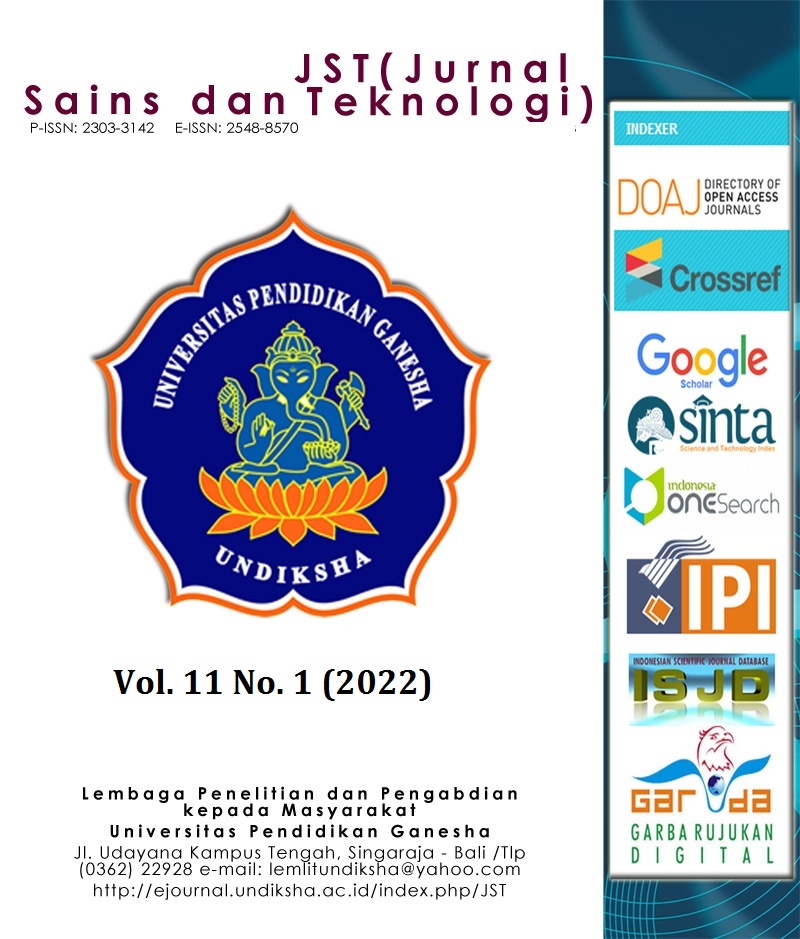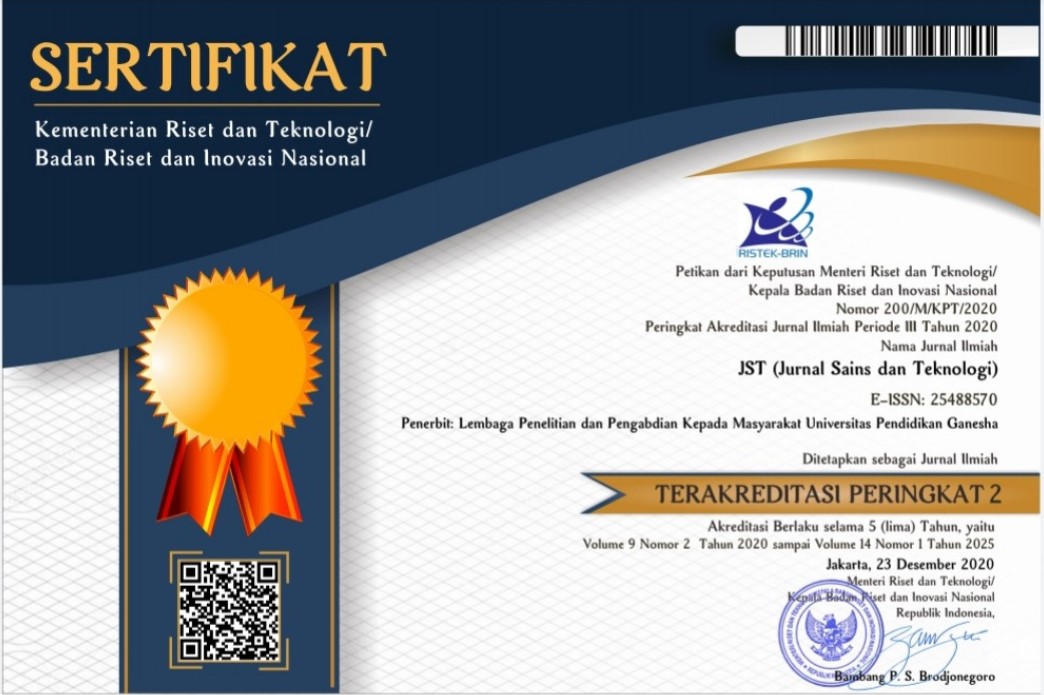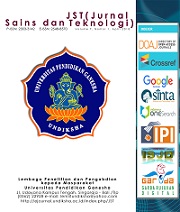Evaluasi Dan Redesign Website Menggunakan System Usability Scale Dan Automated Software Testing
DOI:
https://doi.org/10.23887/jstundiksha.v11i1.40785Kata Kunci:
Website Evaluation, System Usability Scale, Website Performance, User Interface DesignAbstrak
This paper discusses the evaluation and redesign of the STIKI Indonesia website from the usability aspect using the System Usability Scale and User Interface Design as well as the performance aspect using the Pingdom software. This evaluation and redesign is important to do considering that since this website is online, it has only been evaluated once, from the analysis conducted on 19 leaders, the Head of the Institute / UPT STIKI Indonesia that 63.2% said the old website did not contain the expected content, 57.9% stated that there was a plan to load content, 100% agreed that the website content needed to be remapped and the website needed to be redesigned. Furthermore, after the redesign, the new website was evaluated by 40 new STIKI Indonesia students consisting of 25 men and 15 women, with an age range of 17 to 20 years. The results of the System Usability Scale evaluation get an average score of 85.8 or grade A. The average result of the User Interface Design evaluation is 8.4. The results of the performance evaluation using Pingdom get a performance grade of 99 or A.
Referensi
Aini, N., Ibnu Zainal, R., & Afriyudi, A. (2019). Evaluasi Website Pemerintah Kota Prabumulih Melalui Pendekatan Website Usability Evaluation (Webuse). Jurnal Ilmiah Betrik, 10(01), 1–6. https://doi.org/10.36050/betrik.v10i01.20.
Aisyah, S., Saputra, E., Rozanda, N. E., Ahsyar, T. K., Studi, P., Informasi, S., Sains, F., Sultan, U. I. N., & Kasim, S. (2021). Evaluasi Usability Website Dinas Pendidikan Provinsi Riau Menggunakan Metode System Usability Scale. Jurnal Ilmiah Rekayasa Dan Manajemen Sistem Informasi, 7(2), 125–132. https://doi.org/10.24014/rmsi.v7i2.13066.
Atmaja, A. P., & Azis, A. (2019). Sistem Informasi Terintegrasi Evaluasi Kegiatan Mengajar Dosen sebagai Implementasi Sistem Penjaminan Mutu Internal. Matrix : Jurnal Manajemen Teknologi Dan Informatika, 9(1), 1. https://doi.org/10.31940/matrix.v9i1.1243.
Defriani, M., Resmi, M. G., & Jaelani, I. (2021). Uji Usability dengan Metode Cognitive Walkthrough dan System Usability Scale (SUS) pada Situs Web STT Wastukancana. INTECOMS: Journal of Information Technology and Computer Science, 4(1), 30–39. https://doi.org/10.31539/intecoms.v4i1.2072.
Ependi, U., Putra, A., & Panjaitan, F. (2019). Evaluasi Tingkat Kebergunaan Aplikasi Administrasi Penduduk Menggunakan Teknik System Usability Scale. Register: Jurnal Ilmiah Teknologi Sistem Informasi, 5(1), 63–76. https://doi.org/10.26594/register.v5i1.1412.
Faizal, M., Abdillah, M. F., Sari I.M.S, D. A., Setiadi, W., Octavia, D., Suhendari, W., & Soewardikoen, D. W. (2018). Penggunaan Website Portal Berita sebagai Media Informasi untuk Mahasiswa. Jurnal Bahasa Rupa, 2(1), 34–42. https://doi.org/10.31598/bahasarupa.v2i1.217.
Heliany, I. (2019). Wonderful Digital Tourism Indonesia dan Peran Revolusi Industri dalam Menghadapi Era Ekonomi Digital 5.0. Destinesia : Jurnal Hospitaliti Dan Pariwisata, 1(1), 21–35. https://doi.org/10.31334/jd.v1i1.551.
Himawan, Harjanti, T. W., Supriati, R., & Setiyani, H. (2020). Evolusi Penggunaan Teknologi Web 3.0 : Semantic Web. Journal of Information System,Graphics, Hospitality and Technology, 2(02), 54–60. https://doi.org/10.37823/insight.v2i02.107.
Indah, L., & Ari, S. (2018). Rancangan Desain Website Resporsif sebagai Sarana Informasi pada SMK Pustek Serpong. Jurnal Idealis, 2(5), 504–512. https://jom.fti.budiluhur.ac.id/index.php/IDEALIS/article/view/2652.
Intyanto, G. W., Ranggianto, N. A., & Octaviani, V. (2021). Pengukuran Usability pada Website Kampus Akademi Komunitas Negeri Pacitan Menggunakan System Usability Scale (SUS). Walisongo Journal of Information Technology, 3(2), 59–68. https://doi.org/10.21580/wjit.2021.3.2.9549.
Jiwa Permana, A. A. (2019). Usability Testing pada Website E-Commerce Menggunakan Metode System Usability Scale (Sus) (Studi Kasus : Umkmbuleleng.Com). JST (Jurnal Sains Dan Teknologi), 8(2), 149. https://doi.org/10.23887/jst-undiksha.v8i2.22858.
Lestari, M., Haryani, E., & Wahyono, T. (2021). Analisis Kelayakan Sistem Informasi Akademik Universitas Menggunakan PIECES dan TELOS. Jurnal Teknik Informatika Dan Sistem Informasi, 7(2). https://doi.org/10.28932/jutisi.v7i2.3612.
Mashadi, M., Nurachmad, E., & Mulyana, M. (2019). Analisis Deskriptif Penilaian Website Perguruan Tinggi. JAS-PT (Jurnal Analisis Sistem Pendidikan Tinggi Indonesia), 3(2), 97. https://doi.org/10.36339/jaspt.v3i2.278.
Mayasari, A., Supriani, Y., & Arifudin, O. (2021). Implementasi Sistem Informasi Manajemen Akademik Berbasis Teknologi Informasi dalam Meningkatkan Mutu Pelayanan Pembelajaran di SMK. JIIP - Jurnal Ilmiah Ilmu Pendidikan, 4(5), 340–345. https://doi.org/10.54371/jiip.v4i5.277.
Mulyadi, D., & Choliq, A. (2019). Penerapan Metode Human Organization Technology (HOT-Fit Model) untuk Evaluasi Implementasi Aplikasi Sistem Informasi Persediaan (SIDIA) di Lingkungan Pemerintah Kota Bogor. Teknois : Jurnal Ilmiah Teknologi Informasi Dan Sains, 7(2), 1–12. https://doi.org/10.36350/jbs.v7i2.23.
Nazirah, U., & Utami, S. (2018). Pengaruh Kualitas Desain Website terhadap Niat Pembelian Dimediasi oleh Persepsi Kualitas Produk pada Lazada. Co. Id. Jurnal Ilmiah Mahasiswa Ekonomi Manajemen, 2(3), 55–69. https://doi.org/10.24815/jimen.v2i3.3504.
Nuriman, M. L., Mayesti, N., Beny, B., Yani, H., Ningrum, G. M., Darma, U. B., Soejono, A. W., Setyanto, A., & Sofyan, A. F. (2019). Evaluasi Usability Website Menggunakan System Usability Scale. Bina Darma Conference on Computer Science, 2(1), 29–37. https://doi.org/10.35842/jtir.v13i1.213.
Pamungkas, R. (2019). Implementasi HOT-Fit Model dalam Evaluasi Perpustakaan Digital Universitas PGRI Madiun. Jurnal Ilmiah Ilmu Ilmu Teknik, 4(2), 84–89. https://doi.org/10.33319/piltek.v4i2.44.
Pranatawijaya, V. H., Putra, P. B. A. A., & Sari, N. N. K. (2017). Analisis dan Desain Website Monitoring Konsultasi Bimbingan Kartu Rencana Studi (KRS). Junal Teknologi Informasi, 11(1), 58–68. https://doi.org/10.47111/jti.v11i1.1452.
Prawastiyo, C. A., & Hermawan, I. (2020). Pengembangan Front-End Website Perpustakaan Politeknik Negeri Jakarta Menggunakan Metode User Centered Design. Jurnal Teknologi Terpadu, 6(2), 89–95. https://doi.org/10.26623/jisl.v1i2.2784.
Prayitno, H., Achmad, N., Hafizah, H., & Hartanti, D. (2021). Pelatihan Pembuatan Website dalam Menghadapi Perkembangan Teknologi bagi Siswa Di SMK Galajuara Bekasi. Journal of Computer Sains Contribution, 1(2). https://doi.org/10.31599/jucosco.v1i2.592.
Priyono, D., Ramdhani, A., & Hardian, R. (2020). Desain User Interface Informasi Prodi Desain Komunikasi Visual melalui Media Digital Website. Jurnal Desain, 7(3), 223. https://doi.org/10.30998/jd.v7i3.5877.
Putra, M. G. L., Renaldi, M., & Natasia, S. R. (2021). Evaluasi dan Redesign Website Pendidikan Tinggi dengan Menerapkan User Experience Lifecycle. Jurnal Teknologi Informasi Dan Ilmu Komputer, 8(2), 419. https://doi.org/10.25126/jtiik.2021824367.
Rahayu, T., Mayasari, T., & Huriawati, F. (2019). Pengembangan Media Website Hybrid Learning Berbasis Kemampuan Literasi Digital dalam Pembelajaran Fisika. Jurnal Pendidikan Fisika, 7(1), 130. https://doi.org/10.24127/jpf.v7i1.1567.
Rasmila. (2018). Evaluasi Website Dengan Menggunakan System Usability Scale (SUS) pada Perguruan Tinggi Swasta di Palembang. JUSIFO : Jurnal Sistem Informasi, 02(Vol 2 No 1 (2018): JUSIFO), 108–121. https://doi.org/10.19109/jusifo.v4i1.2445.
Sadi, S., Nursubiyantoro, E., Astanti, Y. D., Ismianti, I., Wibowo, A. W. A., & Mastrisiswadi, H. (2021). Usability Evaluation of Scientific Journal Websites using the System Usability Scale (Case Study of the OPSI Journal Website). RSF Conference Series: Engineering and Technology, 1(1), 378–387. https://doi.org/10.31098/cset.v1i1.401.
Salamah, I. (2019). Evaluasi Usability Website PolsridDengan Menggunakan System Usability Scale. 8, 176–183. https://doi.org/10.23887/janapati.v8i3.17311.
Setiawan, A., & Widyanto, R. A. (2018). Evaluasi Website Perguruan Tinggi Menggunakan Metode Usability Testing. Jurnal Informatika: Jurnal Pengembangan IT, 3(3), 295–299. https://doi.org/10.30591/jpit.v3i3.912.
Soeardi, E. K. (2019). Analisis Restrukturisasi dalam Meningkatkan Kualitas Pelayanan Publik pada Kantor Pertanahan Kabupaten Bandung Barat. Decision: Jurnal Administrasi Publik, 1(01), 19. https://doi.org/10.23969/decision.v1i01.1444.
Solahudin, M. (2021). Rancang Bangun Sistem Informasi Akademik Sekolah (SIAS) Berbasis Website. DoubleClick: Journal of Computer and Information Technology, 4(2), 107. https://doi.org/10.25273/doubleclick.v4i2.8315.
Sugiartawan, P., Rustina, I. D. K. R., & Saleh Insani, R. W. (2018). E-Government Media Informasi Alat Kelengkapan Dewan Provinsi Bali dan Media Diskusi Berbasis Website. Jurnal Sistem Informasi Dan Komputer Terapan Indonesia (JSIKTI), 1(2), 75–86. https://doi.org/10.33173/jsikti.17.
Surtikanti, S., Saputra, R. R., Pernanda, F. R., & Saputra, H. (2021). Desain Website untuk Pariwisata. Journal of Information System, Applied, Management, Accounting and Research, 5(3), 613. https://doi.org/10.52362/jisamar.v5i3.475.
Suryawan, I. G. T., & Paramitha, I. G. D. (2020). Analisis Kinerja Website Menggunakan Pendekatan Automated Software Testing. Jurnal Teknologi Informasi Dan Komputer (JuTIK), 6(3), 391–399. http://jurnal.undhirabali.ac.id/index.php/jutik/article/view/1513.
Tujni, B., & Syakti, F. (2019). Implementasi Sistem Usability Scale dalam Evaluasi Perspektif Pengguna terhadap Sistem Informasi Akademik Berbasis Mobile. Ilkom Jurnal Ilmiah, 11(3), 241–251. https://doi.org/10.33096/ilkom.v11i3.479.241-251.
Welda, W., Putra, D. M. D. U., & Dirgayusari, A. M. (2020). Usability Testing Website dengan Menggunakan Metode System Usability Scale (Sus)s. International Journal of Natural Science and Engineering, 4(3), 152. https://doi.org/10.23887/ijnse.v4i2.28864.
Yadi, Y. (2018). Analisa Usability pada Website Traveloka. Jurnal Ilmiah Betrik, 9(03), 172–180. https://doi.org/10.36050/betrik.v9i03.43.
Unduhan
Diterbitkan
Cara Mengutip
Terbitan
Bagian
Lisensi
Hak Cipta (c) 2022 JST (Jurnal Sains dan Teknologi)

Artikel ini berlisensiCreative Commons Attribution-ShareAlike 4.0 International License.
Authors who publish with the Jurnal Sains dan Teknologi (JST) agree to the following terms:
- Authors retain copyright and grant the journal the right of first publication with the work simultaneously licensed under a Creative Commons Attribution License (CC BY-SA 4.0) that allows others to share the work with an acknowledgment of the work's authorship and initial publication in this journal.
- Authors are able to enter into separate, additional contractual arrangements for the non-exclusive distribution of the journal's published version of the work (e.g., post it to an institutional repository or publish it in a book), with an acknowledgment of its initial publication in this journal.
- Authors are permitted and encouraged to post their work online (e.g., in institutional repositories or on their website) prior to and during the submission process, as it can lead to productive exchanges, as well as earlier and greater citation of published work. (See The Effect of Open Access)
















